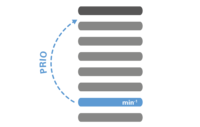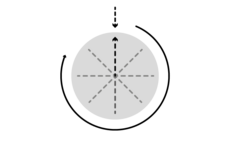Software modules for PSD
February 18, 2021
New software modules for PSD direct drives with IO-Link
halstrup-walcher has expanded its PSD direct drives with IO-Link to include some useful software modules. This means that the drives can now be controlled more quickly and flexibly or used more effectively for applications such as tool changers or conveyor belts.
The IO-Link interface is a cost-effective alternative to the common data buses. This is because less expensive components can be used both for the hardware of the drive and for the cabling. The lower baud rates of the IO-Link interface mean that shielded cables can be dispensed with. And thanks to the star topology via an IO-Link master, a single connector is sufficient to supply and control the drives.
Eliminate transmission time with changeover of parameter set
All these cost advantages have special features in the speed of transmission of parameters compared to other communication interfaces. Due to the lower baud rate, IO-Link is also slower compared to the common data buses. This means that control and feedback - depending on the scope of the desired parameter value changes - may also require longer transmission times. Although these are only in the tenths of a second range, they quickly add up with frequent changes and lead to longer process times.
With the new "changeover of parameter set" software module of the PSD with IO-Link, you can completely eliminate these transmission times. Instead of changing parameter values using slow acyclic commands (ISDUs), you can use set switching to activate up to four different parameter sets directly via two bits in the process data. These four sets each contain 13 parameter values that influence the drive behavior (e.g. setpoint speed, acceleration, traction current). The set changeover command can be sent at any time. The parameter sets are stored in the device


Prioritised processing of target speed in process data
If the application requires a frequent change of the target speed, this can also be included in the process data. This eliminates the need for acyclical access via ISDUs (similar to record switching) and a change in the setpoint speed is processed in the drive immediately after the transmission of the next IO-Link telegram - the undefined transmission time caused by ISDU transmission is thus eliminated. In contrast to the "Set changeover" function, the "Target speed in process data" function can be used to transfer any setpoint speed, whereas with set changeover one of four speeds previously defined in the parameter sets is selected.
The „Modulo“ function enables infinite positioning without limits
The modulo function offers significant advantages if the drive always operates in the same direction of rotation. This can be useful for tool changers, turntables or conveyor belts. In modulo operation, the travel distance is not limited, as is usual in spindle applications with an absolute measuring system. You can define a specific travel path as a so-called modulo width in the software by defining a lower and an upper modulo position as end positions. The characteristic feature here is that the physical position of the driven unit is identical at the lower and upper modulo position. Despite the non-changing direction of rotation and the lack of mechanical end points, the position within the modulo range is always defined. You can position the drive freely within this modulo range - regardless of whether it is currently in the second, tenth or 50th revolution. With the aid of various operating modes, you can approach the target position either in a predefined direction (clockwise or counterclockwise) or by the shortest route.

